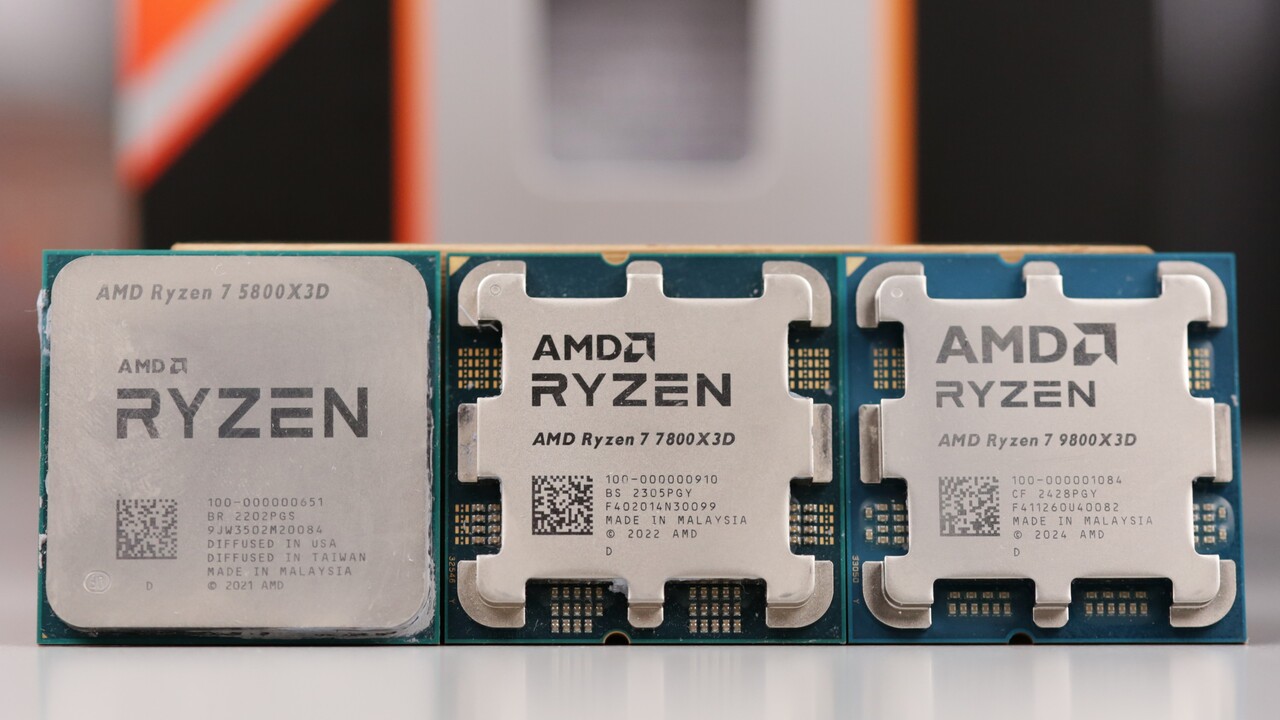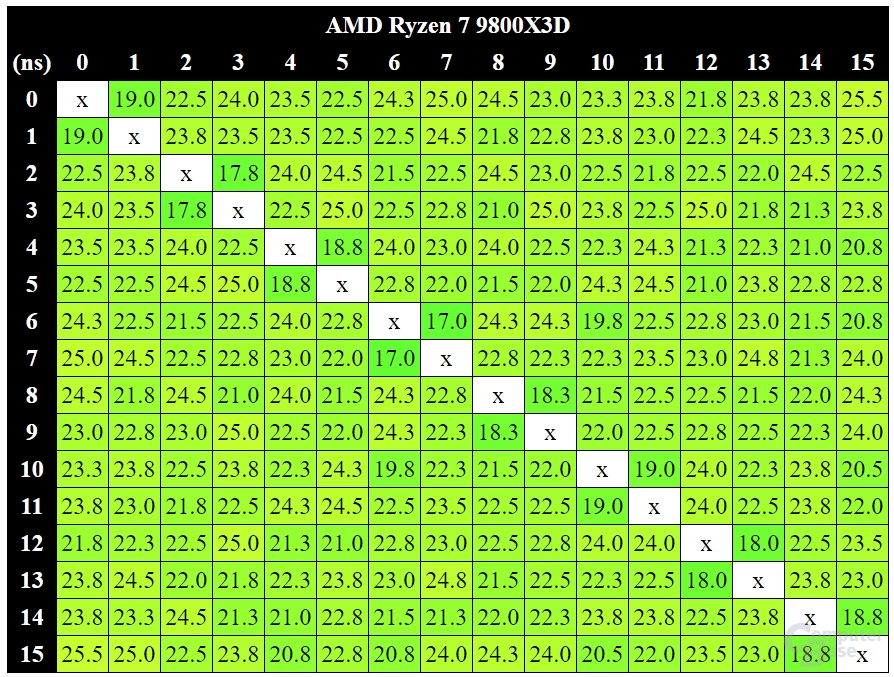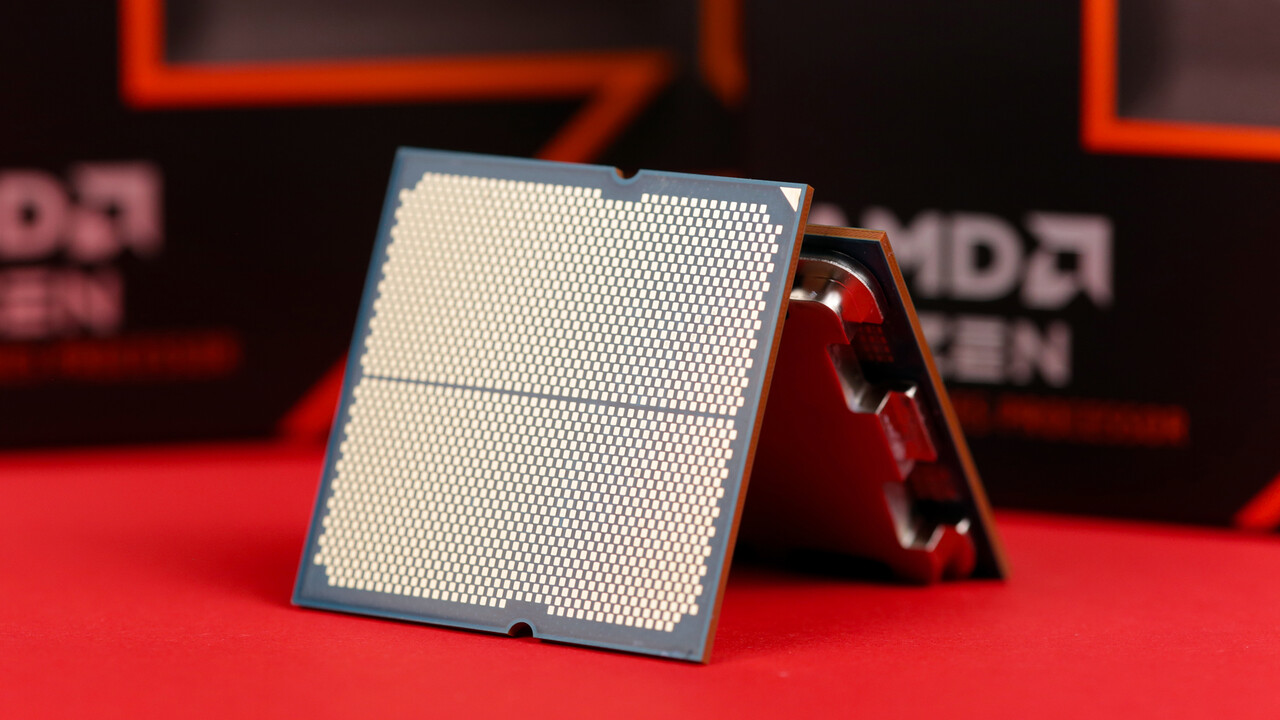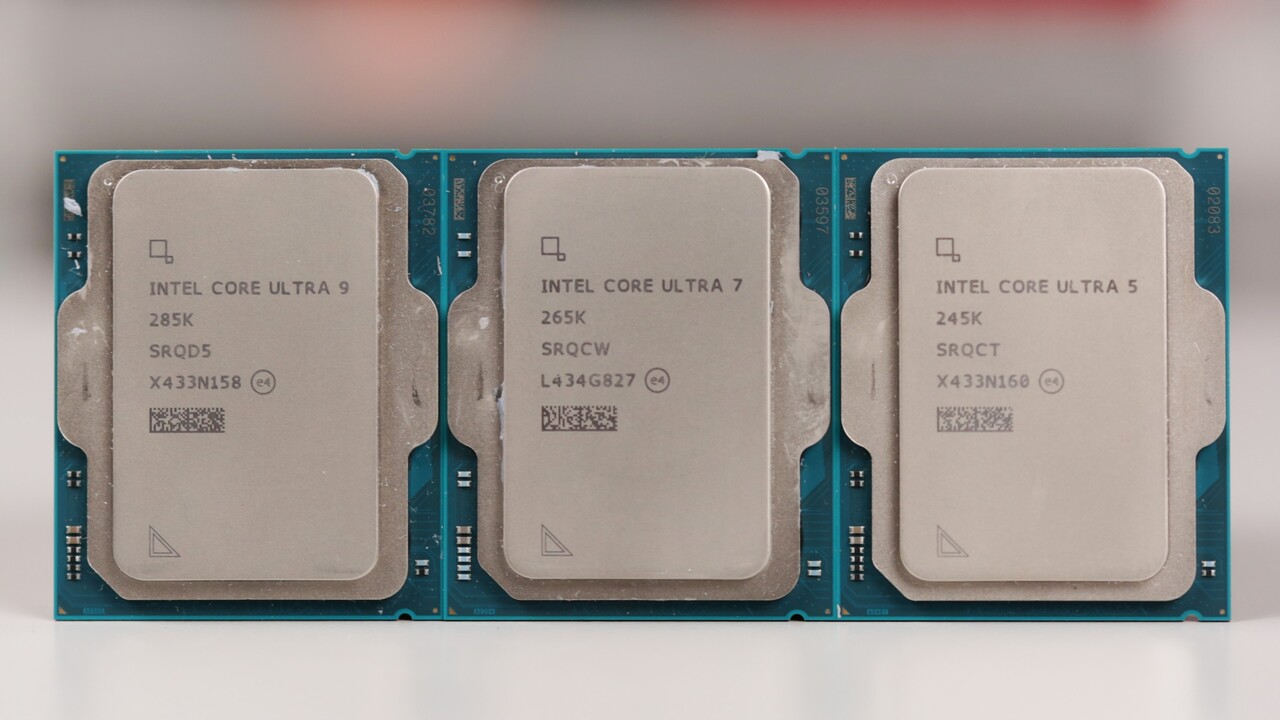AMD Ryzen 7 9800X3D in the test: 9000X3D vs. 7800X3D, 5800X3D & Intel Core Ultra 1,516 comments

The AMD Ryzen 7 9800X3D is the fastest new gaming processor expected, as the test shows with benchmark comparisons to the 7800X3D, 5800X3D and Intel Core Ultra. But the processor shows its biggest improvement elsewhere: it corrects weaknesses in application performance. But this does not work without increased power consumption.
Table of Contents 1 9000X3D vs. 7800X3D, 5800X3D & Intel Core UltraAMD Ryzen 7 9800X3D in the Test Test Results at a Glance AMD Ryzen 7 9800X3D in Detail Trouble-Free Boot 2 Gaming BenchmarksFPS Performance Index and Frame Times Anno 1800 Baldur’s Gate 3 Cities Skylines II Cyberpunk 2077 Dragon’s Dogma 2 F1 24 Frostpunk 2 Ghost of Tsushima Homeworld 3 Horizon Forbidden West Outcast A New Beginning Senua’s Saga: Hellblade II Star Wars Outlaws Starfield Warhammer 40,000: Space Marine 3 Application Benchmarks Multi-Core Performance Single-Core Performance 4 Power Consumption and Temperatures Power Consumption on Windows Desktop Power Consumption under Full Load Power Consumption in Games Full Load Temperatures 5 Application and Gaming EfficiencyApplication EfficiencyGame Efficiency 6 Overclocking, RAM-OC, and Turbo ModeOverclocking from 5.4 to 5.6 GHz RAM-OC (DDR5-7800) Turbo Game Mode (SMT Disabled) 7 Conclusion
AMD Ryzen 7 9800X3D Review
Tomorrow, November 7th, the AMD Ryzen 7 9800X3D, the first processor in the 9000X3D series, will be released. The test embargo falls already today. The processor will cost 529 euros (recommended price), 30 euros more than AMD wanted for its predecessor, the Ryzen 7 7800X3D, when it was launched in spring 2023. There are still eight cores with an additional (gaming) cache, which is now located under the CPU Chiplet and no longer on it. This increases performance – in games, but especially in applications. Techastuce has tested the performance in detail compared to AMD Ryzen 9000X, Ryzen 7 7800X3D, Ryzen 7 5800X3D and Intel Core Ultra. Available from November 7th Buy AMD Ryzen 7 9800X3D at Alternate*Buy AMD Ryzen 7 9800X3D at Caseking* Buy AMD Ryzen 7 9800X3D at Mindfactory*
Test results at a glance
A first small overview of the numerous benchmarks in the test, which mainly compare AMD Ryzen with AMD Ryzen, can already be found here.
In one sentence: The gaming crown, which is by far assured, is now also flanked by high office performance. The turbo mode, which will be available on all AM5 boards via AGESA 1.2.0.2a, remains a gimmick with this CPU and the overclocking announced by AMD is not a selling point – but the CPU does not really need it. The test provides all the details.
Straight to gaming benchmarksStraight to application benchmarksStraight to application and game efficiencyStraight to power consumption and temperaturesOr continue reading…
The test is also available for listening: CB-Funk Episode #90 is exclusively dedicated to the AMD Ryzen 7 9800X3D from A to Z.
The AMD Ryzen 7 9800X3D in detail
The 3D V-Cache migrates to eight Zen 5 cores
The big novelty of the CPU is that the additional second-generation L3 cache module, still measuring 64 MB, is located for the first time under the chiplet (CCD). The cache component no longer represents a thermal barrier between the cores and the heatsink, allowing AMD to run higher clock speeds under full load. Even if the predecessor already offered 120 watts TDP for 162 watts PPT (maximum consumption as long as temperatures permit), it was still far from it in applications. Things are different with the new Ryzen 7 9800X3D.
Other constraints are also lifted: for the first time, an X3D processor can be further overclocked using the open multiplier, just like classic Ryzen processors have always been.
This revolutionary change in placement allows for extreme CPU overclocking. This is the first X3D processor to be fully unlocked, allowing enthusiasts and gamers to push its performance to new limits.
In summary, this creates an eight-core X3D processor without the compromises made previously: it combines high clock speeds like the classic Ryzen 9000 in this class with 3D V-Cache for maximum gaming performance.
The end of 2024 will not be free at AMD either: the surcharge for the AMD Ryzen 7 9700X (test) as an alternative eight-core processor from the Zen 5 family is 130 euros. At 529 euros, the 9800X3D is close to the 539 euros charged by AMD for the 12-core Ryzen 9 9900X. The 9800X3D is undoubtedly an expensive piece of technology.
Architecture core/thread clock
Base/Turbo L2 + L3 TDP iGPU Price UVP (Start) Price (purchase price) AMD Ryzen 9 9950X Zen 5 16/32 4.3/5.7 GHz 16+64 MB 170 W ✓ 709 Euro (ab667 USD) AMD Ryzen 9 9900X Zen 5 12/24 4.4/5.6 GHz 12+64 MB 120 W ✓ 539 Euro (499 USD) to 446 Euro AMD Ryzen 9 7950X3D Zen 4 16/32 4.2/5.6 GHz +64 MB 120 W ✓ 789 Euro (699 USD) to 675 Euro AMD Ryzen 9 7950X Zen 4 16/32 4.5/5.7 GHz 16+64 MB 170 W ✓ 849 Euro (699 USD) to 475 Euro 7X3 AMD/Zen049 24 4.4/5.6 GHz 12+64+64 MB 120 W ✓ 679 Euro (599 USD) to 600 Euro AMD Ryzen 9 7900X Zen 4 12/24 4.7/5.6 GHz 12+64 MB 170 W ✓ 669 Euros (549 USD) for an AMD Ryzen 9 7900 Zen 4 12/24 3.7/5.4 GHz 12+64 MB 65 W at 378 Euros ✓ 479 Euro (429 USD) to 326 Euro AMD Ryzen 7 9800X3D Zen 5 8/15, 4.4 GHz 8+32+64 MB 120 W ✓ 529 Euro (479 USD) AMD Ryzen 7 7800X3D Zen 4 8/16 4.2/5.0 GHz 8+32+64 MB 120 W ✓ 499 Euro (449 USD) ) at 529 Euro 87 AMD Ryzen /16 3.8/5.5 GHz 8+32 MB 65 W ✓ 399 euros (359 USD) to 340 euros AMD Ryzen 7 7700X Zen 4 8/16 4.5/5.4 GHz 8+32 MB 105 W ✓ 479 euros (399 USD) at 287 euros AMD Ryzen 7 7700 Zen 4 8/16 3.8/5.3 GHz 8+32 MB 65 W ✓ 369 euros (329 USD) to 277 euros AMD Ryzen 5 9600X Zen 5 6/12 3.9/5.4 GHz 6+ 32 MB 65 W ✓ 309 euros (279 USD) to 245 euros AMD Ryzen 5 7600X3D Zen 4 6/12 4.1/4.7 GHz 6+32+64 MB 65 W ✓ 329 euros (299 USD) to 299 euros AMD Ryzen 5 76406/ Zen12.7/5.3 GHz 6+32 MB 105 W ✓ 359 euros (299 USD) to 199 euros AMD Ryzen 5 7600 Zen 4 6/12 3.8/5.1 GHz 6+32 MB 65 W ✓ 259 euros (2291 euros) on Ryzen 5 7500F Zen 4 6/12 3.7/5.0 GHz 6+32 MB 65 W – ? Euro (179 USD) from 158 euros
The classic Zen 5 is based on the V -3D Cache
The underlying CPU architecture (more literally) with the code name Zen 5 is otherwise completely identical to the AMD Ryzen 9000 series processors previously introduced in the AMD Ryzen 7 9800X3D.
This also means that the IPC, which has increased by around 15%, must be added to the clock speed increases the newcomer brings over its predecessor X3D. The combined result is particularly evident in applications during testing, but also in some games like clock speed + IPC gain.
A trouble-free start
Despite the short-term postponement, the launch of the AMD Ryzen 9000X this summer was heartbreaking: the platform and firmware/BIOS simply weren’t ready yet and the problems were endless.
The AMD Ryzen 7 9800X3D can now be based on the clean AGESA base launched at the end of September with the launch of the 800 series chipsets – whether on 800 or 600 series motherboards. All the problems that hit AMD this have been addressed, including increased inter-core latencies, which are not present in the AMD Ryzen 7 9800X3D.
AMD Ryzen 7 9800X3D Inter-Core Latency
 Even the small update of AGESA from version 1.2.0.2 to 1.2.0.2a does not derail the solution. It mainly integrates Turbo mode, already used in the media (see Gigabyte X3D Turbo Mode or Asus Game Turbo Mode), but its relevance for the new X3D processor is almost non-existent, as the test will show.
Even the small update of AGESA from version 1.2.0.2 to 1.2.0.2a does not derail the solution. It mainly integrates Turbo mode, already used in the media (see Gigabyte X3D Turbo Mode or Asus Game Turbo Mode), but its relevance for the new X3D processor is almost non-existent, as the test will show.
What is “Turbo Mode” for? Disables simultaneous multithreading. Disables the 2nd chiplet on dual chiplet processors
AMD has also finally fixed some of the issues with the AMD chipset driver and constant SSD changes for almost every CPU the editorial team mentioned this summer.
They are still only available as a workaround, but in the future it should also be possible for AMD to switch from a solution with one CCD to a CPU with two CCDs and vice versa without constant reinstallation – including X3D processors. While this is primarily a concern for testers, one or two customers of a new processor could fall into the same trap without a new Windows on the same platform.
AMD recommends a fresh installation of the operating system for each processor change on a system. However, it is no longer necessary to reinstall Windows 11 when switching between AMD 1-CCD and 2-CCD processors. Keep in mind that although the chipset provisioning driver can work without reinstalling the operating system, there are other reasons why a fresh installation of the operating system is important.
Some AMD processors use Game Bar, Game Mode, and provisioning processor power management optimizations. For example, the Ryzen 9 7950X3D uses these technologies when a game is detected to prefer the 3D V-cache core complex and park the non-3D V-cache core complex to enable higher gaming performance. Previously, there was a known issue where incorrect provisioning CPU power management settings could be applied after the user changed the installed AMD CPU, for example from a 2CCD Ryzen 9 7950X3D to a Ryzen 7 7800X3D with 1 CCD.
The Windows 11 user experience has improved thanks to the new “AMD Provisioning Packages Service”. This service manages AMD provisioning packages, including CPU and NVMe power management. It will automatically uninstall then reinstall AMD provisioning packages using PowerShell cmdlets if the processor name has changed. Other provisioning packages are not modified by this service. So this is a partial workaround for users experiencing incorrect provisioning after changing processor vendor, family, model, or name. Because PowerShell cmdlets are used as the provisioning installation method, users can confirm that AMD provisioning packages are installed using Windows Settings: Accounts > Go to Work or School > Add or delete a provisioning package.
AMD
For today’s test, the editorial team continued to play it safe and ran all processors with the same chipset configuration on their own SSD with a new Windows 11 24H2. Five SSDs or Windows installations were used only for AMD processors: for 9800X3D, for 7800X3D, 5800X3D, 9950X + 9900X and 9700X + 9600X.
Links marked with an asterisk are affiliate links. If an order is placed via such a link, Techconseil will share the proceeds of the sale without increasing the price to the customer.
Page 1/7 Next page

Marc deciphers processors by testing their performance for gaming, content creation, and artificial intelligence.


